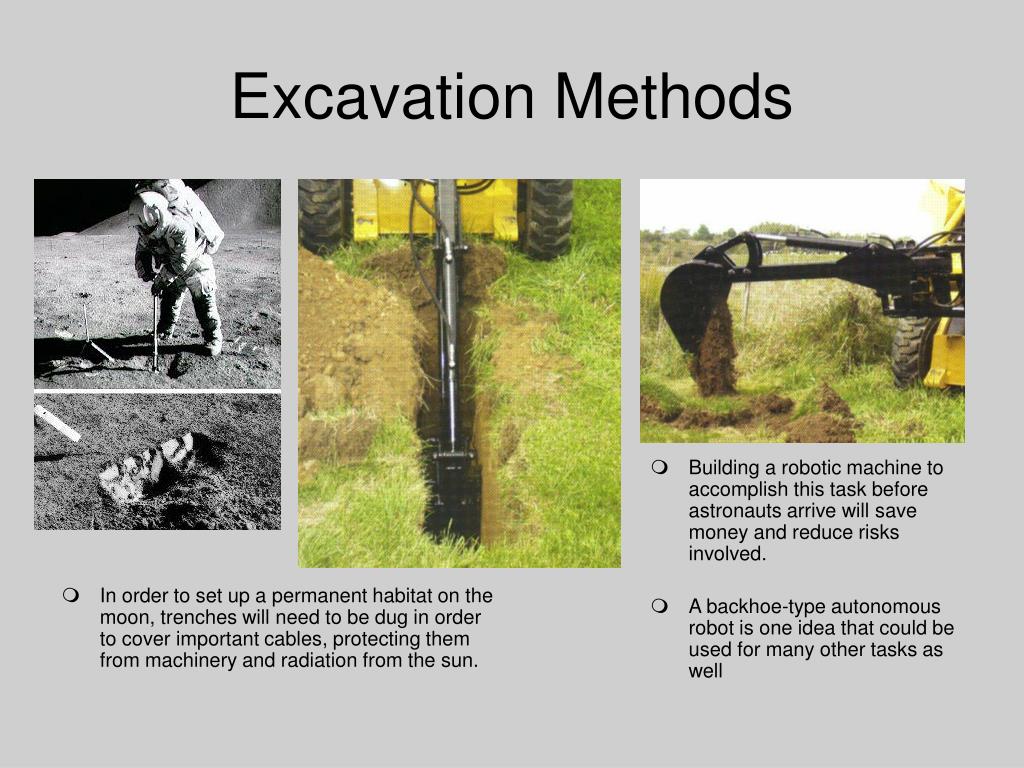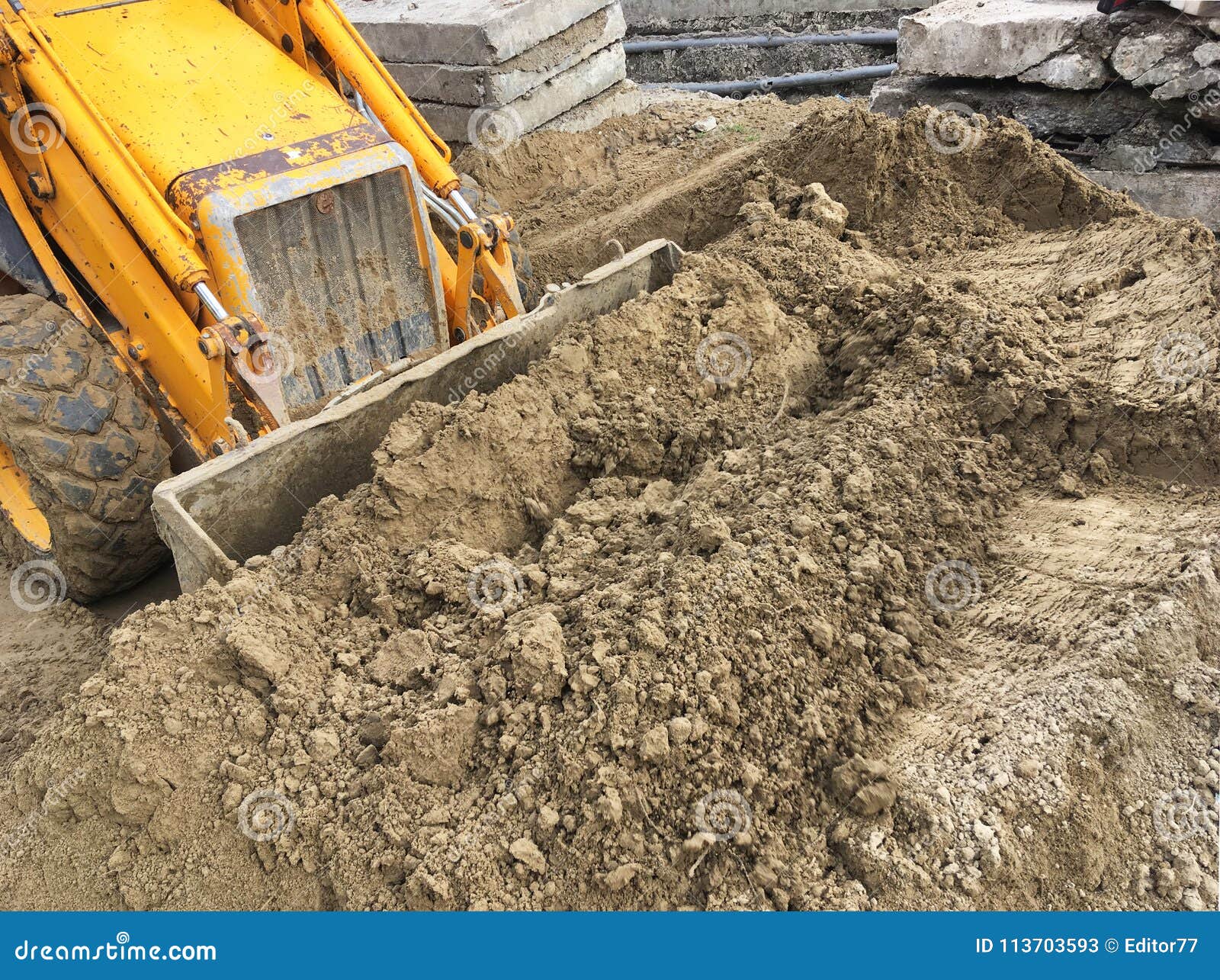Fascination About Excavator
Wiki Article
Our Excavation Companies PDFs
Table of ContentsFacts About Excavator UncoveredTrencher Fundamentals ExplainedExcavator Things To Know Before You Get ThisRumored Buzz on Concrete ContractorsHow Grading Contractors can Save You Time, Stress, and Money.


Scrapers or Pans excavate soil in one place, haul as well as discard the soil in another area (general contractor). It is difficult to match the efficiency of scrapes for cut/fill soil procedure if the haul distance is less then a mile. Scrapers are typically pulled by a rubber tire wheel tractor as well as are occasionally pressed with the cut area by a bulldozer.
There are several times that scrapes are not utilized for website grading and also a dump vehicle is used: the haul may be to long, the haul may cross roads where scrapers are not permitted, acid rock may be run into, devices schedule, etc. Dispose trucks remain in common usage as well as probably require little conversation.
Numerous trucks have a top-hinged tailgate that can not dispose any kind of rock bigger after that the tailgate size. "Rock body" beds, on the other hand, have no tailgates and can unload any kind of dimension rock, although their volume ability is lessened. These web links show tools specs for numerous usual dump trucks. Compaction Devices increases the thickness of the soil and also sometimes gives a smooth, rolled surface.
Getting My Excavating Contractors To Work
From an easy examination pit to percussion exploration to core boring the owner has increasingly a lot more costly choices that produce progressively far better data concerning the site underground. The Proprietor on a 100,000 SF structure project might license twenty dull locations with split spoon dirt examples taken until rock is reached as well as after that core examples of rock.Recognizing the kind as well as quality of rock (from the core samples) and also area of rock (from the soils boring) is a real benefit in jobsite preparation. On the other hand, the Proprietor of a 100,000 SF building might determine to wage no geotechnical testing whatsoever. The choice regarding geotechnical testing is usually made by a Proprietor without any input from the Building and construction Supervisor.
The section on Soils and Geology aids you comprehend the terms in the geotechnical record. An expertise of the approximate location of the rock helps the Building and construction Supervisor to intend the series of steps following rock excavation. If rock is in one edge of a big structure project, for instance, the planet excavation could start at the opposite end of the building in order to begin foundation work soonest.
Beginning the foundation job early would be a good suggestion if the rock might be eliminated by ripping. Nevertheless, if the rock is extremely hard and also calls for substantial blasting, it might be prudent to hold foundation job up until the blasting is finished. The Building and construction Supervisor need to collaborate these kinds of choices and utilize all the technological date readily available.
The 9-Second Trick For General Contractor
Unclassified excavation specifies that all rock or other unforeseen materials (omitting unsafe materials) run into in the sitework will be the responsibility of the Service provider at no change in agreement price. An unclassified excavation is less complex from a book-keeping perspective and puts the responsibility for geotechnical conditions onto the Sitework Specialist.Just How Water Impacts Sitework? It's incredible what a heavy rainfall can do to a building and construction job. Prior to the rainfall, the website might be completely dry, hefty devices successfully relocating planet, the various other professions smoothly performing their job. Within hours the job can be a sloppy, mud-hole with employee efficiency cut to regarding 10%.
In many areas of the world, the Building and construction Manager have to remember an easy fact: IT WILL CERTAINLY RAINFALL. Great preparation can lessen the damage and also interruption of a heavy rain to a jobsite. Usually the excavation and also grading is entrusted to the Sitework Service Provider (and also their Foremen is responsible to manage and also guide the hefty equipment and operators).
The Building and construction Manager need try this out to be constantly aware of what rainfall will do to the task site. It is not uncommon for the Sitework Supervisor to function their heavy tools for optimal efficiency and also wish it does not rain. Among the finest means to get ready for rain is to incline all grades to drain and also to smooth rolled the surface prior to a rain.
7 Simple Techniques For Grading Contractors
The Construction Supervisor must be well-balanced sufficient to insure that hefty rainfall does not quit job on the task much longer than needed. Daily conversations with Sitework Foremen may be needed to achieve this goal. At any time excavation is called for listed below the existing groundwater level on a job, the process of dewatering must be taken into consideration.In a genuinely cohesive soil, the water travels so gradually via the clay or silt that dewatering is not normally necessary for the relatively short time of excavation. Dewatering might be needed for a single footing excavation or for a whole job site. One of the most typical dewatering approaches are trench drains, deep wells and well points.

Ground water infiltration can likewise be decreased by cutoff approaches such as sheet stacking. The prices for dewatering can be staggering, consisting of equipment service, labor as well as electrical power (or gas). High dewatering costs have faded the earnings margins on far way too many tasks. The several variables listed here make the work of approximating dewatering expenses very difficult, and also extremely inexact.
This alternative should always be considered when assessing the possibility of dewatering. Undoubtedly the alternative is only feasible if gravity can run the water to reduced ground. Trench drains pipes can be cut with a backhoe and also filled with a crude, granular material (# 4 stone for instance), yet care has to be worked out in choosing the water electrical outlet type as well as area.
Rumored Buzz on Trencher
A siphon, by meaning, makes use of air pressure to bring water from the original source one elevation, up over a challenge, to a lower elevation. The pipes in a siphon system have to be closed and some resourcefulness is usually needed to entirely fill the siphon pipeline. The siphon pipeline must be full for the siphon to begin.A deep well contains a pump, hose and an upright well casing. The pump intake is at the bottom of the well casing (normally some smashed stone is put down there as a filter tool) (mini excavator). The water is inflated the hose, out of the well case, great site and also to an ideal discharge place.
In a coarse sand, for instance, a large area can be pumped to near the pump consumption altitude. A much less permeable soil, on the various other hand, decreases the efficiency of a deep well. Since the pump is typically at the end of the deep well, there are no height constraints due to vacuum lift, and deep wells can lower the groundwater over 50 feet.
On the bottom of the wellpoint there is a 2 foot long screen as well as shutoff, water jets out of this shutoff and also develops an opening right into which the wellpoint pipeline can be reduced. This opening is typically made a bigger diameter (for instance 10 inches) to enable a rugged sand backfill to assist filter the water (trencher).
Report this wiki page